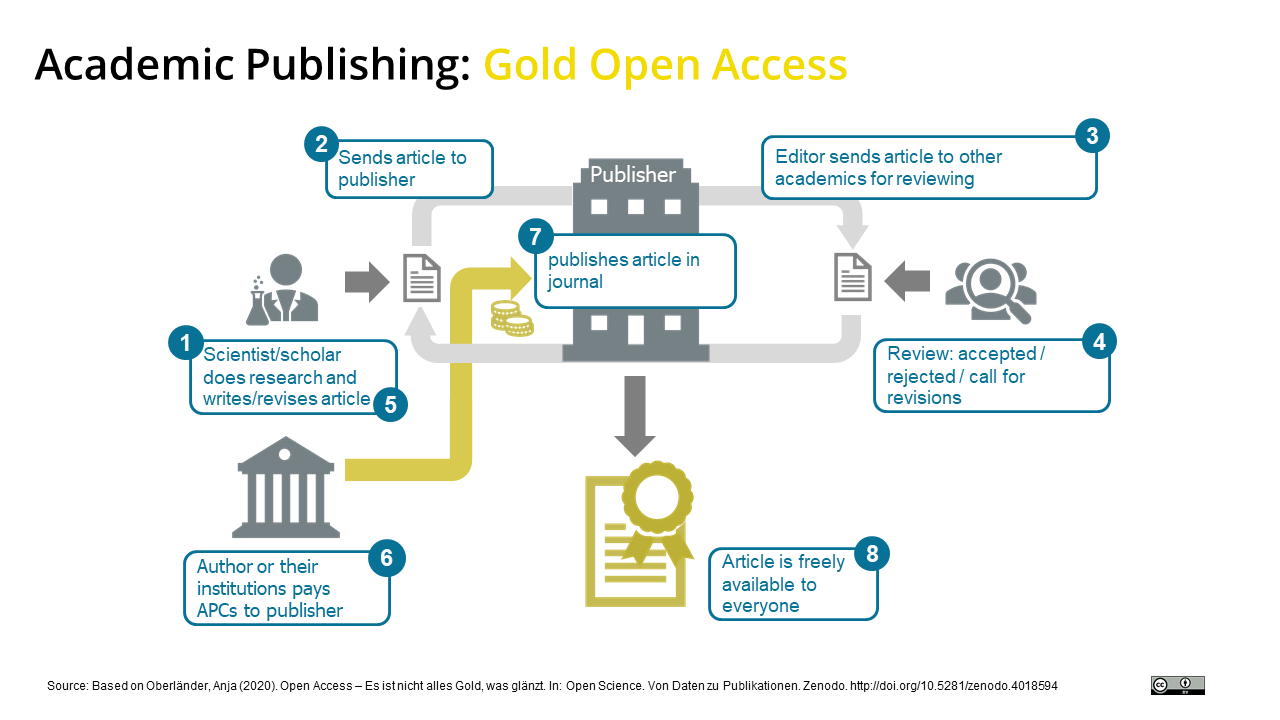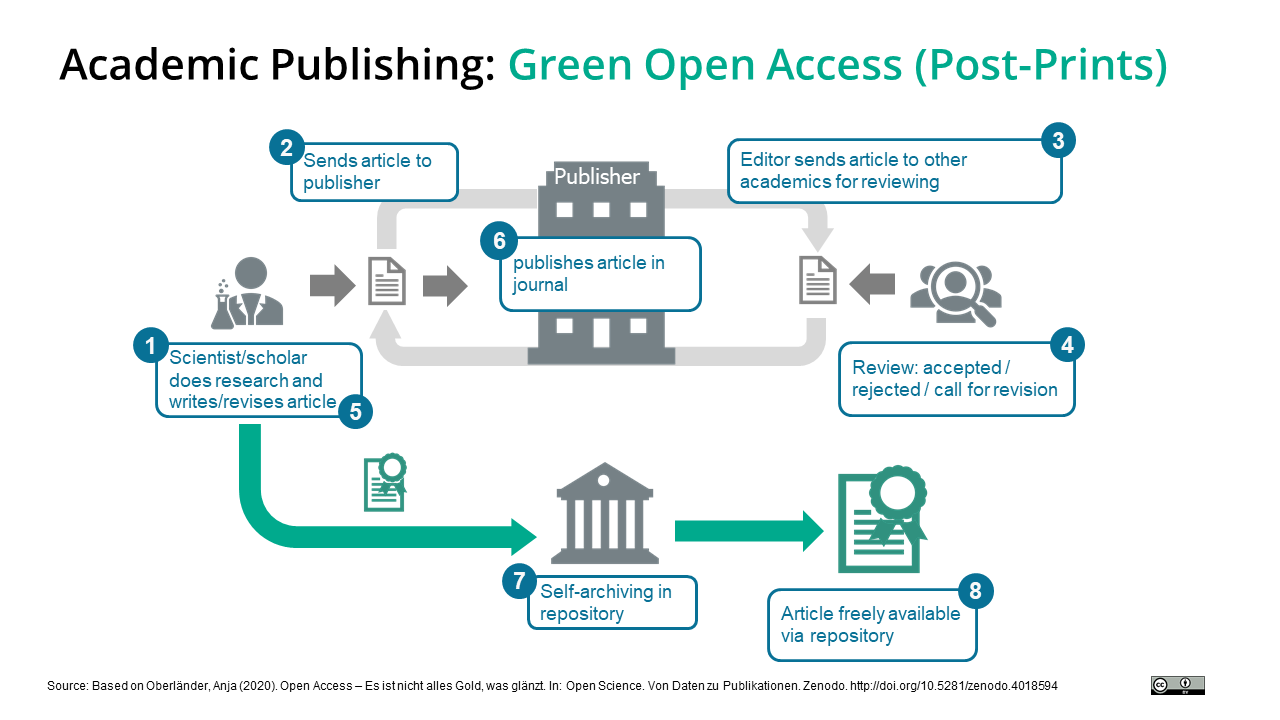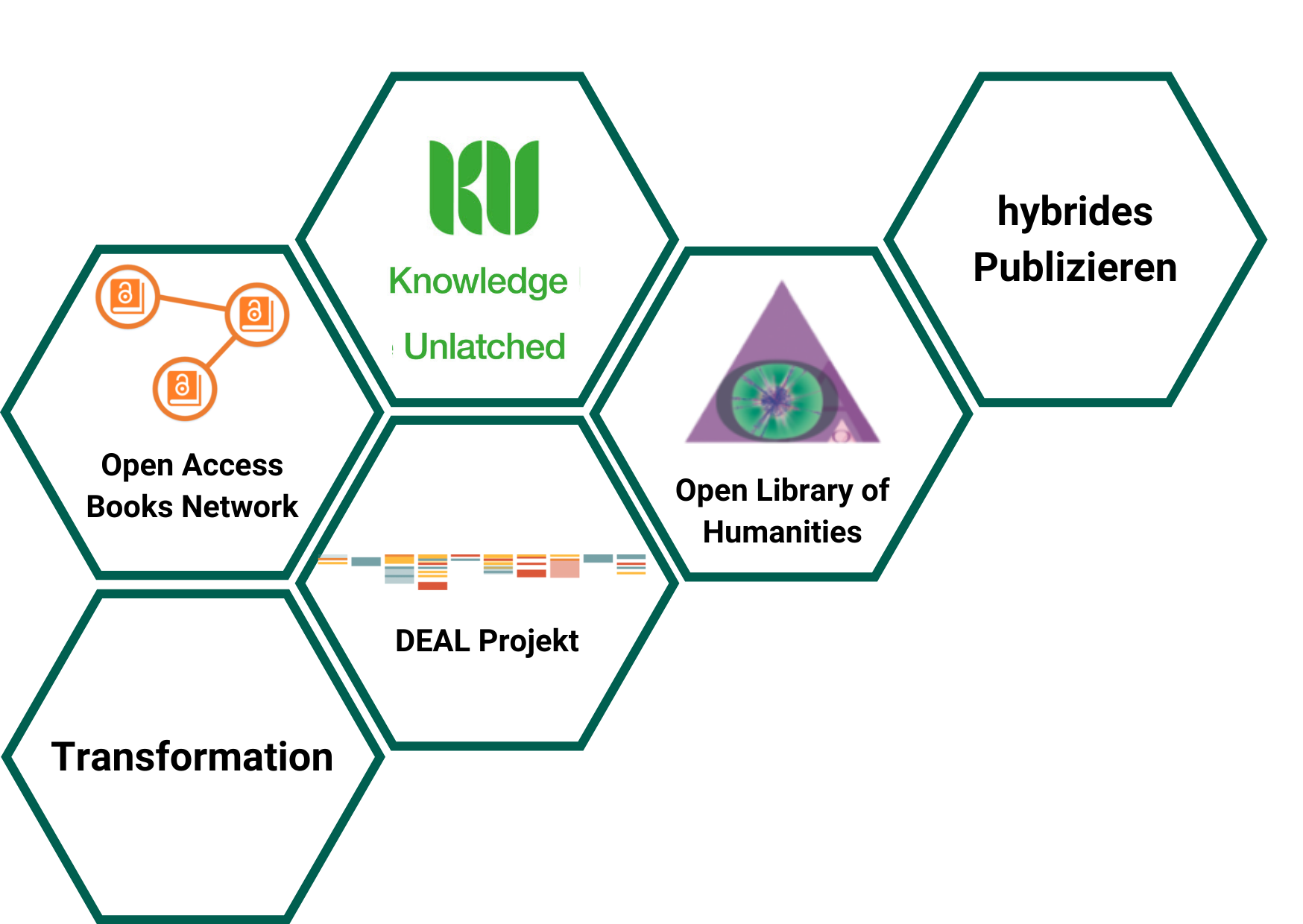Search

Open Access - Publication manners
The most familiar Open Access publication manners are the Golden and the Green way. There are also other types of open access, such as hybrid and diamond.
Chemnitz University of Technology supports all of the open access models mentioned.
Golden Way of Open Access for primary publications
The Golden Way designates the immediate free availability of original publications. The contents may be published either in an Open Access journal, an Open Access monograph or in a freely available conference publication. Frequently, charges are raised for that which are often covered by the institution.

- Scholar does research and elaborates / revises article
- Submits article to publisher
- Editor forwards article for review to other scholars
- Review: approval / rejection / request for revision
- Scholar does research and elaborates/ revises article
- Author resp. his / her institution pays APC’s to the publisher
- Publisher releases article in journal
- Article openly accessible for all
What means the publication within the Golden Way of Open Access?
The publications are released by a publisher and are immediately freely accessible already at the time of primary publication.
What should be observed?
The same as in the case of traditional publishing, quality assurance plays also an important role here. For the coverage of the business model, Article Processing Charges (APC) are often raised. Please observe the information regarding dubious publishers. In case of doubts face to the policy or business model of the publisher, please address to the University Library PRIOR the submission of the paper as in the worst case unnecessary expenses may emerge. We also assist within the selection of an appropriate publication carrier. Normally, a publication contract is concluded with the respective publisher including information which rights for use will be conceded to the publisher and which conditions for use are contracted. The concession of rights may be implemented in the manner of a simple or exclusive right for use for a limited or unlimited period of time.
In addition, the usage may be expanded by a Free License erweitert werden. In that way, the authors concede further detailed rights to the users. In Germany, the Creative-Commons-Licenses are very familiar. Out of those, CC-BY is the most open one. The publication by CC-BY is recommended by the Open Access Policy of Chemnitz University of Technology.
CC-Licenses containing the ND-clause are not in compliance with the Berlin Declaration asking for concession of the right of processing to the users.
Green Way of Open Access for secondary publications
The Green Way of Open Access offers the opportunity of re-publication of already released articles or other kinds of documents without restricted access. The so-called secondary publication is implemented within a subject-specific or institutional repository (self-archiving). The re-publication may happen either at the same time or subsequent to the publication of the contents by a publisher.

- Scholar does research and elaborates / revises article
- Submits article to publisher
- Editor forwards article for review to other scholars
- Review: approval/ rejection / request for revision
- Scholar does research and elaborates / revises article
- Publisher releases article in journal
- Re-publication within a repository
- Article openly accessible via repository
What is the difference between the Green Way and the Golden Way of Open Access?
The Golden Way is somehow the direct Open-Access-publication at the publisher. The selection of a CC-license is safely possible as far as you are the holder of copyrights.
On the Green Way, a re-publication happens, this time within a repository. Normally, no publication charges will be raised for that. An Open Content-license is frequently not possible in this context as the rights were often already conceded to the publisher unless the publisher has assigned that kind of license to the primary publication. In the case of publication on the Green Way, the embargo delays and the requirements of the publishers/ journals have to be observed
How do I find relevant articles appropriate to turn them into Open Access?
Dissemin is a tool for searching for publications which are currently not openly accessible but could be provided
for that on the Green Way. By a color code, Golden and Green Open Access-publications are marked which are already openly accessible.
Blue publications are appropriate for Open Access-publishing according to the valid regulations of the publisher. By an ORCID, the Upload into one of the following
repositories is immediately possible.
- HAL is the Open Access-repository for all current and former adherents and members of Darmstadt University of Technology.
- Zenodo is a repository run by CERN. A DOI is assigned to the document.
- We recommend you to contact the Open Science Team with regard to archiving within the publication system MONARCH-Qucosa of Chemnitz University of Technology.
How do I settle usage rights for a secondary publication?
Information regarding policies of the publishers and of the respective journals are provided by the database Jisc's open policy finder (formerly Sherpa services). Within the category “Publisher policy”, Open Access-rights are indicated according to the version of the article. The record contains the requirements for a secondary publication, information concerning potential embargos and the conditions such as i.a. “Must link to publisher version”.
By example of the journal “Nature”, which may be found by simple search as title or via ISSN, the structure and the meaning of the icons are easily comprehensible.
Within the category “Help” video tutorials and user guides are provided. The tab “About” leads to detailed information about the database.
In the case you have already published in a journal, we would be delighted to assist you to archive your article in an openly accessible way. Please get in touch with us!
Hybrid Publications

Publications released as print as well as digitally are designated as hybrid publications.
For instance, it may be possible that articles released in subscription journals may be provided also openly accessible by payment of a charge. Within the transformation agreements with publishers, hybrid Open Access-publications become more and more significant.
By targeted negotiations, double-financing of different expenses shall be avoided. As new business model, the transfer of publication costs to publication-based payment is intended and the permanent reading component is integrated (PAR-fee = Publish & Read).
On that way, adherents of involved institutions get unrestricted access to all academic journals of the publishers and may at the same time publish Open Access without additional expenses (costs for printing or surcharges are not included).
Diamond Open Access (DOA)
What is a Diamond Open Access publication?
Based on other (international) projects such as CODRIA, DIAMAS, CRAFT-OA, PLATO the Diamond Open Access Service Center (SeDOA) formulated the following minimum definitions as a common understanding:
- In Diamond Open Access journals, quality-assured contributions are published free of charge for authors and readers under an open access-compliant license. The
journal or title rights belong to the scientific community.
Diamond Open Access journals serve scientific communication and non-commercial purposes. - In diamond open access books, quality-checked content is published free of charge for authors and readers under an open naccess-compliant license. The book and
series titles belong to the scientific community.
Diamond open access books serve scientific communication and non-commercial purposes.

National funding
- The German Research Association (DFG) supports this sustainable approach by funding the establishment of a national service point (SeDOA – Service Point for Diamond Open Access) from 2025 on for three years at first. This service point will be part of the European Diamond Capacity Hub (EDCH).
- In addition, the DFG has concluded a three-year agreement with the Directory of Open Access Journals (DOAJ). Since the end of 2024, the inclusion in the DOAJ is a requirement for the eligibility for funding within the DFG-program Infrastructures for scientific publishing. The program Open-Access-Publication Costs recommends the orientation at DOAJ-criteria as well.
- The Federal Ministry for Research, Technology and Space (BMFTR) supports several programs in this context.
- Recently, information regarding programs for consortium financing is provided in concentrated manner by the Diamond Funding Navigator.
Finding Diamond Open Access Journals
- Electronic Journals Library (EZB) List according categories
- List of German Diamond-Open-Access-Journals of the University of Bielefeld, 2022
- Directory of Open Access Journals (DOAJ)
- B!SON - Bibliometric and Semantic Open Access Recommender Network, Betaversion
- oa.finder by Open-access.network including impact, information on costs and funding opportunities
